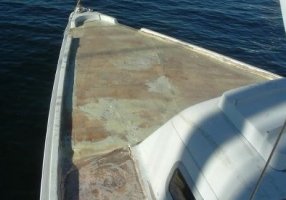I removed my bow running lights on my E27 to repair the wires and noticed that both holes drilled into the bow section for the lights are damp. The reside is rusty brown and has a consistency of light syrup - not just "wet wood". The lights were caked with silicone and water has crept into the fixtures and down the holes. I've temporarily caulked with butyl rubber to block further water ingress until it dries out around here enough to effect a proper repair.
After a bit of research it appears this will require drying, then resealing the wood with epoxy. I'm looking very hard at this Git Rot epoxy which has been recommended by others on this forum.
After the last rain, it looks like a few of the pulpit rail holes are weeping water as well, which are just a few inches from the lights. The topside of the puplit mounting bases had a rusty ring that has stained the fiberglass.
Long-term, I intend to mount an anchor roller extension and relocate the running lights to the pulpit rail.
Question: What is the best way to dry the wood in this cramped area?
I'm thinking about this solution when we have a dry spell:
- Spray an evaporative water-displacing spray liberally into all of the holes. Something that leaves no residue such as denatured alcohol (which I have read works for this type of water problem).
- Place a (thermostat-controlled) space heater up in the V-berth and removing the lights and bow pulpit.
- Run this for a few days to heat up the area and dry the wood. How long should it run?
- Run Git Rot (or another penetrating epoxy) through the holes.
- Reattach the hardware with 4200.
I'm not comfortable drilling a bunch of holes in this area... just doesn't seem like a good idea. It would seem that the 6x holes for the bow pulpit mounts, the large hole for the anchor line, and the two large holes for the existing lights would be enough surface area?
TIA,
- Jerry
After a bit of research it appears this will require drying, then resealing the wood with epoxy. I'm looking very hard at this Git Rot epoxy which has been recommended by others on this forum.
After the last rain, it looks like a few of the pulpit rail holes are weeping water as well, which are just a few inches from the lights. The topside of the puplit mounting bases had a rusty ring that has stained the fiberglass.
Long-term, I intend to mount an anchor roller extension and relocate the running lights to the pulpit rail.
Question: What is the best way to dry the wood in this cramped area?
I'm thinking about this solution when we have a dry spell:
- Spray an evaporative water-displacing spray liberally into all of the holes. Something that leaves no residue such as denatured alcohol (which I have read works for this type of water problem).
- Place a (thermostat-controlled) space heater up in the V-berth and removing the lights and bow pulpit.
- Run this for a few days to heat up the area and dry the wood. How long should it run?
- Run Git Rot (or another penetrating epoxy) through the holes.
- Reattach the hardware with 4200.
I'm not comfortable drilling a bunch of holes in this area... just doesn't seem like a good idea. It would seem that the 6x holes for the bow pulpit mounts, the large hole for the anchor line, and the two large holes for the existing lights would be enough surface area?
TIA,
- Jerry
Last edited:



